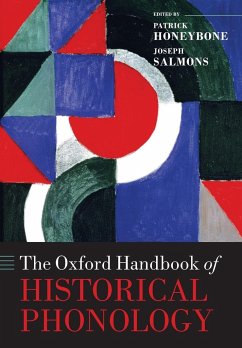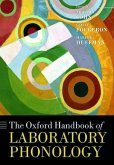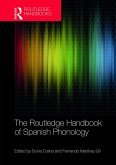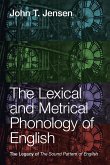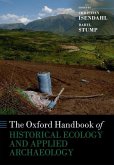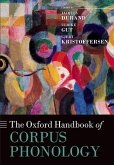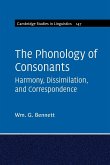The Oxford Handbook of Historical Phonology
Herausgeber: Honeybone, Patrick; Salmons, Joseph
The Oxford Handbook of Historical Phonology
Herausgeber: Honeybone, Patrick; Salmons, Joseph
- Broschiertes Buch
- Merkliste
- Auf die Merkliste
- Bewerten Bewerten
- Teilen
- Produkt teilen
- Produkterinnerung
- Produkterinnerung
This critical overview examines every aspect of the field including its history, key current research questions and methods, theoretical perspectives, and sociolinguistic factors. The authors represent leading proponents of every theoretical perspective. The book is a valuable resource for phonologists and a stimulating guide for their students.
Andere Kunden interessierten sich auch für
![The Oxford Handbook of Laboratory Phonology The Oxford Handbook of Laboratory Phonology]() The Oxford Handbook of Laboratory Phonology219,99 €
The Oxford Handbook of Laboratory Phonology219,99 €![The Routledge Handbook of Spanish Phonology The Routledge Handbook of Spanish Phonology]() The Routledge Handbook of Spanish Phonology260,99 €
The Routledge Handbook of Spanish Phonology260,99 €![The Sounds of Language The Sounds of Language]() Elizabeth C. Zsiga (USA Georgetown University)The Sounds of Language43,99 €
Elizabeth C. Zsiga (USA Georgetown University)The Sounds of Language43,99 €![The Lexical and Metrical Phonology of English The Lexical and Metrical Phonology of English]() John T. Jensen (University of Ottawa)The Lexical and Metrical Phonology of English39,99 €
John T. Jensen (University of Ottawa)The Lexical and Metrical Phonology of English39,99 €![The Oxford Handbook of Historical Ecology and Applied Archaeology The Oxford Handbook of Historical Ecology and Applied Archaeology]() The Oxford Handbook of Historical Ecology and Applied Archaeology204,99 €
The Oxford Handbook of Historical Ecology and Applied Archaeology204,99 €![Ohb Corpus Phonology Ohbk C Ohb Corpus Phonology Ohbk C]() Durand Et AlOhb Corpus Phonology Ohbk C202,99 €
Durand Et AlOhb Corpus Phonology Ohbk C202,99 €![The Phonology of Consonants The Phonology of Consonants]() Wm G. Bennett (South Africa Rhodes University)The Phonology of Consonants42,99 €
Wm G. Bennett (South Africa Rhodes University)The Phonology of Consonants42,99 €-
-
-
This critical overview examines every aspect of the field including its history, key current research questions and methods, theoretical perspectives, and sociolinguistic factors. The authors represent leading proponents of every theoretical perspective. The book is a valuable resource for phonologists and a stimulating guide for their students.
Hinweis: Dieser Artikel kann nur an eine deutsche Lieferadresse ausgeliefert werden.
Hinweis: Dieser Artikel kann nur an eine deutsche Lieferadresse ausgeliefert werden.
Produktdetails
- Produktdetails
- Oxford Handbooks
- Verlag: Oxford University Press
- Seitenzahl: 812
- Erscheinungstermin: 5. Oktober 2017
- Englisch
- Abmessung: 244mm x 170mm x 44mm
- Gewicht: 1384g
- ISBN-13: 9780198814139
- ISBN-10: 0198814135
- Artikelnr.: 50435643
- Herstellerkennzeichnung
- Libri GmbH
- Europaallee 1
- 36244 Bad Hersfeld
- gpsr@libri.de
- Oxford Handbooks
- Verlag: Oxford University Press
- Seitenzahl: 812
- Erscheinungstermin: 5. Oktober 2017
- Englisch
- Abmessung: 244mm x 170mm x 44mm
- Gewicht: 1384g
- ISBN-13: 9780198814139
- ISBN-10: 0198814135
- Artikelnr.: 50435643
- Herstellerkennzeichnung
- Libri GmbH
- Europaallee 1
- 36244 Bad Hersfeld
- gpsr@libri.de
Patrick Honeybone is Senior Lecturer in Linguistics and English Language at the University of Edinburgh where his main interests are historical phonology, phonological theory, and northern English dialects. He has published articles in English Language and Linguistics, Lingua, Language Sciences, and a range of other journals. He is the main organizer of the annual Manchester Phonology Meeting. Joseph Salmons is the Lester W.J. "Smoky" Seifert Professor of Germanic Linguistics. He is the author of A History of German, (OUP 2012), and serves as executive editor of Diachronica: International Journal of Historical Linguistics.
* Part I Introduction and Context
* 1: Patrick Honeybone and Joseph Salmons: Introduction: Key Questions
for Historical Phonology
* 2: Robert W. Murray: The Early History of Historical Phonology
* 3: Joseph Salmons and Patrick Honeybone: Structuralist Historical
Phonology: Systems in Segmental Change
* Part II: Evidence and Methods in Historical Phonology
* 4: Anthony Fox: Phonological Reconstruction
* 5: Donka Minkova: Establishing Phonemic Contrast in Written Sources
* 6: J. Marshall Unger: Interpreting Diffuse Orthographies and
Orthographic Change
* 7: Roger Lass: Interpreting Alphabetic Orthographies: Early Middle
English Spelling
* 8: Martin Kümmel: The Role of Typology in Historical Phonology
* 9: Brett Kessler: Computational and Quantitative Approaches to
Historical Phonology
* 10: Andrew Wedel: Simulation as an Investigative Tool in Historical
Phonology
* 11: Warren Maguire: Using Corpora of Recorded Speech for Historical
Phonology
* 12: Matthew J. Gordon: Exploring Chain Shifts, Mergers, and
Near-Mergers as Changes in Progress
* Part III: Types of Phonological Change
* 13: András Cser: Basic Types of Phonological Change
* 14: David Fertig: Analogy and Morphophonological Change
* 15: Aditi Lahiri: Change in Word Prosody: Stress and Quantity
* 16: Martha Ratliff: Tonoexodus, Tonogenesis, and Tone Change
* 17: Laura Catharine Smith and Adam Ussishkin: The Role of Prosodic
Templates in Diachrony
* Part IV: Fundamental Controversies in Phonological Change
* 18: Paul Foulkes and Marilyn Vihman: First Language Acquisition and
Phonological Change
* 19: Tobias Scheer: How Diachronic is Synchronic Grammar? Crazy Rules,
Regularity, and Naturalness
* 20: Mark Hale, Madelyn Kissock, and Charles Reiss: An I-Language
Approach to Phonologization and Lexification
* 21: Betty S. Phillips: Lexical Diffusion in Historical Phonology
* 22: Ricardo Bermúdez-Otero: Amphichronic Explanation and the Life
Cycle of Phonological Processes
* 23: Mark J. Jones: Individuals, Innovation, and Change
* 24: Alan C. L. Yu: The Role of Experimental Investigation in
Understanding Sound Change
* Part V: Theoretical Historical Phonology
* 25: Patricia J. Donegan and Geoffrey S. Nathan: Natural Phonology and
Sound Change
* 26: Robert Mailhammer, David Restle, and Theo Vennemann: Preference
Laws in Phonological Change
* 27: Joan Bybee: Articulatory Processing and Frequency of Use in Sound
Change
* 28: Juliette Blevins: Evolutionary Phonology: A Holistic Approach to
Sound Change Typology
* 29: B. Elan Dresher: Rule-based Generative Historical Phonology
* 30: Thomas Purnell and Eric Raimy: Distinctive Features, Levels of
Representation, and Historical Phonology
* 31: D. Eric Holt: Historical Sound Change in Optimality Theory:
Achievements and Challenges
* 32: Paul Kiparsky: Phonologization
* Part VI: Sociolinguistic and Exogenous Factors in Historical
Phonology
* 33: Alexandra D'Arcy: Variation, Transmission, Incrementation
* 34: David Bowie and Malcah Yaeger-Dror: Phonological Change in Real
Time
* 35: Daniel Schreier: Historical Phonology and Koinéization
* 36: Fred R. Eckman and Gregory K. Iverson: Second Language
Acquisition and Phonological Change
* 37: Christian Uffmann: Loanword Adaptation
* References
* Indexes
* 1: Patrick Honeybone and Joseph Salmons: Introduction: Key Questions
for Historical Phonology
* 2: Robert W. Murray: The Early History of Historical Phonology
* 3: Joseph Salmons and Patrick Honeybone: Structuralist Historical
Phonology: Systems in Segmental Change
* Part II: Evidence and Methods in Historical Phonology
* 4: Anthony Fox: Phonological Reconstruction
* 5: Donka Minkova: Establishing Phonemic Contrast in Written Sources
* 6: J. Marshall Unger: Interpreting Diffuse Orthographies and
Orthographic Change
* 7: Roger Lass: Interpreting Alphabetic Orthographies: Early Middle
English Spelling
* 8: Martin Kümmel: The Role of Typology in Historical Phonology
* 9: Brett Kessler: Computational and Quantitative Approaches to
Historical Phonology
* 10: Andrew Wedel: Simulation as an Investigative Tool in Historical
Phonology
* 11: Warren Maguire: Using Corpora of Recorded Speech for Historical
Phonology
* 12: Matthew J. Gordon: Exploring Chain Shifts, Mergers, and
Near-Mergers as Changes in Progress
* Part III: Types of Phonological Change
* 13: András Cser: Basic Types of Phonological Change
* 14: David Fertig: Analogy and Morphophonological Change
* 15: Aditi Lahiri: Change in Word Prosody: Stress and Quantity
* 16: Martha Ratliff: Tonoexodus, Tonogenesis, and Tone Change
* 17: Laura Catharine Smith and Adam Ussishkin: The Role of Prosodic
Templates in Diachrony
* Part IV: Fundamental Controversies in Phonological Change
* 18: Paul Foulkes and Marilyn Vihman: First Language Acquisition and
Phonological Change
* 19: Tobias Scheer: How Diachronic is Synchronic Grammar? Crazy Rules,
Regularity, and Naturalness
* 20: Mark Hale, Madelyn Kissock, and Charles Reiss: An I-Language
Approach to Phonologization and Lexification
* 21: Betty S. Phillips: Lexical Diffusion in Historical Phonology
* 22: Ricardo Bermúdez-Otero: Amphichronic Explanation and the Life
Cycle of Phonological Processes
* 23: Mark J. Jones: Individuals, Innovation, and Change
* 24: Alan C. L. Yu: The Role of Experimental Investigation in
Understanding Sound Change
* Part V: Theoretical Historical Phonology
* 25: Patricia J. Donegan and Geoffrey S. Nathan: Natural Phonology and
Sound Change
* 26: Robert Mailhammer, David Restle, and Theo Vennemann: Preference
Laws in Phonological Change
* 27: Joan Bybee: Articulatory Processing and Frequency of Use in Sound
Change
* 28: Juliette Blevins: Evolutionary Phonology: A Holistic Approach to
Sound Change Typology
* 29: B. Elan Dresher: Rule-based Generative Historical Phonology
* 30: Thomas Purnell and Eric Raimy: Distinctive Features, Levels of
Representation, and Historical Phonology
* 31: D. Eric Holt: Historical Sound Change in Optimality Theory:
Achievements and Challenges
* 32: Paul Kiparsky: Phonologization
* Part VI: Sociolinguistic and Exogenous Factors in Historical
Phonology
* 33: Alexandra D'Arcy: Variation, Transmission, Incrementation
* 34: David Bowie and Malcah Yaeger-Dror: Phonological Change in Real
Time
* 35: Daniel Schreier: Historical Phonology and Koinéization
* 36: Fred R. Eckman and Gregory K. Iverson: Second Language
Acquisition and Phonological Change
* 37: Christian Uffmann: Loanword Adaptation
* References
* Indexes
* Part I Introduction and Context
* 1: Patrick Honeybone and Joseph Salmons: Introduction: Key Questions
for Historical Phonology
* 2: Robert W. Murray: The Early History of Historical Phonology
* 3: Joseph Salmons and Patrick Honeybone: Structuralist Historical
Phonology: Systems in Segmental Change
* Part II: Evidence and Methods in Historical Phonology
* 4: Anthony Fox: Phonological Reconstruction
* 5: Donka Minkova: Establishing Phonemic Contrast in Written Sources
* 6: J. Marshall Unger: Interpreting Diffuse Orthographies and
Orthographic Change
* 7: Roger Lass: Interpreting Alphabetic Orthographies: Early Middle
English Spelling
* 8: Martin Kümmel: The Role of Typology in Historical Phonology
* 9: Brett Kessler: Computational and Quantitative Approaches to
Historical Phonology
* 10: Andrew Wedel: Simulation as an Investigative Tool in Historical
Phonology
* 11: Warren Maguire: Using Corpora of Recorded Speech for Historical
Phonology
* 12: Matthew J. Gordon: Exploring Chain Shifts, Mergers, and
Near-Mergers as Changes in Progress
* Part III: Types of Phonological Change
* 13: András Cser: Basic Types of Phonological Change
* 14: David Fertig: Analogy and Morphophonological Change
* 15: Aditi Lahiri: Change in Word Prosody: Stress and Quantity
* 16: Martha Ratliff: Tonoexodus, Tonogenesis, and Tone Change
* 17: Laura Catharine Smith and Adam Ussishkin: The Role of Prosodic
Templates in Diachrony
* Part IV: Fundamental Controversies in Phonological Change
* 18: Paul Foulkes and Marilyn Vihman: First Language Acquisition and
Phonological Change
* 19: Tobias Scheer: How Diachronic is Synchronic Grammar? Crazy Rules,
Regularity, and Naturalness
* 20: Mark Hale, Madelyn Kissock, and Charles Reiss: An I-Language
Approach to Phonologization and Lexification
* 21: Betty S. Phillips: Lexical Diffusion in Historical Phonology
* 22: Ricardo Bermúdez-Otero: Amphichronic Explanation and the Life
Cycle of Phonological Processes
* 23: Mark J. Jones: Individuals, Innovation, and Change
* 24: Alan C. L. Yu: The Role of Experimental Investigation in
Understanding Sound Change
* Part V: Theoretical Historical Phonology
* 25: Patricia J. Donegan and Geoffrey S. Nathan: Natural Phonology and
Sound Change
* 26: Robert Mailhammer, David Restle, and Theo Vennemann: Preference
Laws in Phonological Change
* 27: Joan Bybee: Articulatory Processing and Frequency of Use in Sound
Change
* 28: Juliette Blevins: Evolutionary Phonology: A Holistic Approach to
Sound Change Typology
* 29: B. Elan Dresher: Rule-based Generative Historical Phonology
* 30: Thomas Purnell and Eric Raimy: Distinctive Features, Levels of
Representation, and Historical Phonology
* 31: D. Eric Holt: Historical Sound Change in Optimality Theory:
Achievements and Challenges
* 32: Paul Kiparsky: Phonologization
* Part VI: Sociolinguistic and Exogenous Factors in Historical
Phonology
* 33: Alexandra D'Arcy: Variation, Transmission, Incrementation
* 34: David Bowie and Malcah Yaeger-Dror: Phonological Change in Real
Time
* 35: Daniel Schreier: Historical Phonology and Koinéization
* 36: Fred R. Eckman and Gregory K. Iverson: Second Language
Acquisition and Phonological Change
* 37: Christian Uffmann: Loanword Adaptation
* References
* Indexes
* 1: Patrick Honeybone and Joseph Salmons: Introduction: Key Questions
for Historical Phonology
* 2: Robert W. Murray: The Early History of Historical Phonology
* 3: Joseph Salmons and Patrick Honeybone: Structuralist Historical
Phonology: Systems in Segmental Change
* Part II: Evidence and Methods in Historical Phonology
* 4: Anthony Fox: Phonological Reconstruction
* 5: Donka Minkova: Establishing Phonemic Contrast in Written Sources
* 6: J. Marshall Unger: Interpreting Diffuse Orthographies and
Orthographic Change
* 7: Roger Lass: Interpreting Alphabetic Orthographies: Early Middle
English Spelling
* 8: Martin Kümmel: The Role of Typology in Historical Phonology
* 9: Brett Kessler: Computational and Quantitative Approaches to
Historical Phonology
* 10: Andrew Wedel: Simulation as an Investigative Tool in Historical
Phonology
* 11: Warren Maguire: Using Corpora of Recorded Speech for Historical
Phonology
* 12: Matthew J. Gordon: Exploring Chain Shifts, Mergers, and
Near-Mergers as Changes in Progress
* Part III: Types of Phonological Change
* 13: András Cser: Basic Types of Phonological Change
* 14: David Fertig: Analogy and Morphophonological Change
* 15: Aditi Lahiri: Change in Word Prosody: Stress and Quantity
* 16: Martha Ratliff: Tonoexodus, Tonogenesis, and Tone Change
* 17: Laura Catharine Smith and Adam Ussishkin: The Role of Prosodic
Templates in Diachrony
* Part IV: Fundamental Controversies in Phonological Change
* 18: Paul Foulkes and Marilyn Vihman: First Language Acquisition and
Phonological Change
* 19: Tobias Scheer: How Diachronic is Synchronic Grammar? Crazy Rules,
Regularity, and Naturalness
* 20: Mark Hale, Madelyn Kissock, and Charles Reiss: An I-Language
Approach to Phonologization and Lexification
* 21: Betty S. Phillips: Lexical Diffusion in Historical Phonology
* 22: Ricardo Bermúdez-Otero: Amphichronic Explanation and the Life
Cycle of Phonological Processes
* 23: Mark J. Jones: Individuals, Innovation, and Change
* 24: Alan C. L. Yu: The Role of Experimental Investigation in
Understanding Sound Change
* Part V: Theoretical Historical Phonology
* 25: Patricia J. Donegan and Geoffrey S. Nathan: Natural Phonology and
Sound Change
* 26: Robert Mailhammer, David Restle, and Theo Vennemann: Preference
Laws in Phonological Change
* 27: Joan Bybee: Articulatory Processing and Frequency of Use in Sound
Change
* 28: Juliette Blevins: Evolutionary Phonology: A Holistic Approach to
Sound Change Typology
* 29: B. Elan Dresher: Rule-based Generative Historical Phonology
* 30: Thomas Purnell and Eric Raimy: Distinctive Features, Levels of
Representation, and Historical Phonology
* 31: D. Eric Holt: Historical Sound Change in Optimality Theory:
Achievements and Challenges
* 32: Paul Kiparsky: Phonologization
* Part VI: Sociolinguistic and Exogenous Factors in Historical
Phonology
* 33: Alexandra D'Arcy: Variation, Transmission, Incrementation
* 34: David Bowie and Malcah Yaeger-Dror: Phonological Change in Real
Time
* 35: Daniel Schreier: Historical Phonology and Koinéization
* 36: Fred R. Eckman and Gregory K. Iverson: Second Language
Acquisition and Phonological Change
* 37: Christian Uffmann: Loanword Adaptation
* References
* Indexes

